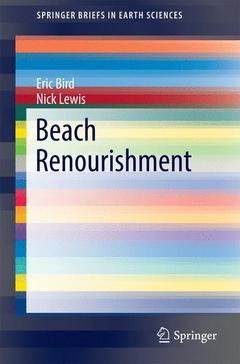Beach Renourishment, 2015 SpringerBriefs in Earth Sciences Series
Auteurs : Bird Eric, Lewis Nick

Beach renourishment is the restoration of beaches that have been depleted. The text deals with the sources of beach sediment as well as the causes and typical responses to beach erosion, before discussion of beach renourishment.
Some of the first documented renourishment projects were undertaken in the early 1900?s on the east coast of the United States. Several countries have since renourished beaches, particularly during the past few decades. Most projects have been in the United States, the United Kingdom, some European countries and Australia. These are reviewed and experience from various beach renourishment projects used for discussion of the following topics:
1. The need for preliminary investigations
2. Sources of sediment for beach renourishment
3. Methods of beach renourishment
4. Design considerations
5. Monitoring changes after beach renourishment
6. Assessment of performance
7. Modelling of beach renourishment
8. Beach renourishment for coast protection
9. Environmental impacts
10. Costs and benefits
11. Response of renourished beaches to a rising sea level
1.Introduction
2. Causes of Beach Erosion
3. Responses to Beach Erosion
4. Beach Renourishment Principles
5. Beach Renourishment For Coastal Protection
6. Planning Considerations
7. Review of International Practices
8. Conclusion
Includes supplementary material: sn.pub/extras
Date de parution : 10-2014
Ouvrage de 137 p.
15.5x23.5 cm
Thèmes de Beach Renourishment :
Mots-clés :
Beach Erosion and Beach Management; Beach Fill and Beach Nourishment; Beach Fill and Beach Renourishment; Beach Nourishment; Beach Renourishment; Coastal Erosion and Beach Fill; Coastal Management and Beach Nourishment; Coastal Management and Beach Renourishment; Shore Nourishment; Shore Renourishment; coastal sciences



